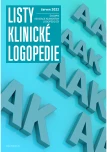INCIDENCE OF DISFLUENCIES IN THE DISCOURSES OF HEALTHY ADULTS
Authors:
Kevická Viktória 1; Marková Jana 1; Buntová Dana 1
Published in:
Listy klinické logopedie 2022; 6(1): 63-69
Category:
Miscellaneous
doi:
https://doi.org/10.36833/lkl.2022.001
Overview
Several factors can affect the fluency of discourse production and the occurrence of disfluencies within it. Mostly the influence on language production of age, education and gender is considered. However, to date, we know relatively little about the influence of these factors on the incidence of disfluencies in the discourses of the healthy adult population. Therefore, the aim of our research was to provide a more comprehensive view of this issue. We compared the incidence of disfluencies in male and female discourses, in three age and three educational categories, working with a total sample of 182 participants. According to our results, age, education, and gender do not affect the overall incidence of disfluencies in discourse production, but each factor affects the incidence of a particular type of disfluency. Age affects the occurrence of interjections, phonological and semantic corrections, as well as corrections in general. Education influences the occurrence of part-word repetitions and grammatical corrections. Gender affects the occurrence of word repetitions.
Keywords:
disfluencies – discourse – effect of aging – effect of education – effect of gender
Sources
- ASHAIE, S., OBLER, L. 2014. Effect of Age, Education, and Bilingualism on Confrontation Naming in Older Illiterate and Low-Educated Populations. Behavioural Neurology [online], 2014. DOI: 10.1155/2014/970520.
- BORTFELD, H. et al. 2001. Disfluency rates in conversation: effects of age, relationship, topic, role, and gender. Language and Speech, 44(2), s. 123-147. DOI: 10.1177/00238309010440020101.
- CARUSO, A. J., MCCLOWRY, T., MAX, L. 1997. Age-related effects on speech fluency. Seminars in Speech and Language, 18(2), s. 171-180. DOI: 10.1055/s-2008-1064071.
- DUCHIN, S. W., MYSAK, E. D. 1987. Disfluency and rate characteristics of young adult, middle-aged, and older males. Journal of Communication Disorders, 20(3), s. 245-257. DOI: 10.1016/0021-9924(87)90022-0.
- HORTON, W. S., SPIELER, D. H., SHRIBERG, E. 2010. A corpus analysis of patterns of age-related change in conversational speech. Psychology of aging, 25(3), s. 708-713. DOI: 10.1037/a0019424.
- KEVICKÁ, V., MARKOVÁ, J., BUNTOVÁ, D. 2021. Analýza spontánnej reči a jej využitie v klinickej praxi. Bratislava: Univerzita Komenského. ISBN 978-80-223-5097-6.
- LE DORZE, G., BÉDARD, C. 1998. Effects of age and education on the lexico-semantic content of connected speech in adults. Journal of Communication Disorders, 31(1), s. 53-70. DOI: 10.1016/s0021-9924(97)00051-8.
- LE DORZE, G., DUROCHER, J. 1992. The Effects of Age, Educational Level, and Stimulus Length on Naming in Normal Subjects. Journal of Speech-Language Pathology and Audiology, 16(1), s. 21-29.
- LEEPER, L. H., CULATTA, R. 1995. Speech fluency: Effect of Age, Gender and Context. Folia Phoniatrica et Logopaedica, 47(1), s. 1-14. DOI: 10.1159/000266337.
- LECHTA, V. 2004. Koktavost. Praha: Portál. ISBN 80-7178-867-8.
- LECHTA, V. 2016. Zajakavosť. In KEREKRÉTIOVÁ, A. a kol. Logopédia. Bratislava: Univerzita Komenského. ISBN 978-80-223-4165-3.
- MURMAN, D. L. 2015. The impact of age on cognition. Seminars in Hearing, 36(3), s. 111-121. DOI: 10.1055/s-0035-1555115.
- RASTLE, K. G., BURKE, D. M. 1996. Priming the tip of the tongue: Effects of prior processing on word retrieval in young and older adults. Journal of Memory and Language, 35, s. 586-605. DOI: 10.1006/JMLA.1996.0031.
- SHRIBERG, E. 1996. Disfluencies in Switchboard. Proceedings of International Conference on Spoken Language Processing, Addendum, s. 11-14.
- SIMOS, P. G., KASSELIMIS, D., MOUZAKI, A. 2011. Age, gender, and education effects on vocabulary measures in Greek. Aphasiology, 25(4), s. 475-491. DOI: 10.1080/02687038.2010.512118.
- WHEATERSBY, A. J. 2016. Disfluency and ageing: A study of healthy older speakers of New Zealand English. Dissertation Theses. New Zealand: University of Canterbury.
- YAIRI, E., AMBROSE, N. 1999. Normative dysfluency data for early childhood stuttering. In Journal of Speech, Language and Hearing Research, vol. 42, s. 895-909.
- YAIRI, E., AMBROSE, N. 2005. Early Childhood Stuttering. For Clinicians by Clinicians. USA: Pro-ed. ISBN 9780890799857.
- ZANICHELLI, L., FONSECA, R. P., ORTIZ, K. Z. 2020. Influence of age and schooling in written discourse of healthy adults. Psicologia: Reflexao e Crítica, 33(10). DOI: 10.1186/s41155-020-00148-7.
Labels
Clinical speech therapy General practitioner for children and adolescentsArticle was published in
Clinical speech therapy (Listy klinické logopedie)

2022 Issue 1
- Hope Awakens with Early Diagnosis of Parkinson's Disease Based on Skin Odor
- What Effect Can Be Expected from Limosilactobacillus reuteri in Mucositis and Peri-Implantitis?
- Deep stimulation of the globus pallidus improved clinical symptoms in a patient with refractory parkinsonism and genetic mutation
- The Importance of Limosilactobacillus reuteri in Administration to Diabetics with Gingivitis
Most read in this issue
- FACILITATION-SYSTEMIC THERAPY
- PRACTICAL USE OF CORE VOCABULARY AND MODELLING IN AUGMENTATIVE AND ALTERNATIVE COMMUNICATION
- ALTERNATIVE AND AUGMENTATIVE COMMUNICATION IN AMYOTROPHIC LATERAL SCLEROSIS PATIENTS
- THE MOST IMPORTANT PARAMETERS OF BOTTLE NIPPLES CURRENTLY USED IN THE CZECH REPUBLIC FOR FEEDING PRETERM INFANTS WHO ARE HOSPITALISED
